Visible-Light-Curable Solvent-Free Acrylic Pressure-Sensitive Adhesives via Photoredox-Mediated Radical Polymerization
Abstract
1. Introduction
2. Results and Discussion
2.1. Strategy
2.2. Preparation of Solvent-Free Acrylic PSAs
2.2.1. Bulk Polymerization
2.2.2. Film Curing
2.3. Characterization of Solvent-Free Acrylic PSAs
2.3.1. Gel Content
2.3.2. Transparency
2.3.3. Adhesion Performances
3. Materials and Methods
3.1. Materials
3.2. Preparation of the Solvent-Free Acrylic PSA
3.2.1. Bulk Polymerization
3.2.2. Film Curing
3.3. Characterization of the Solvent-Free Acrylic PSA
3.3.1. Gel Content
3.3.2. Adhesive Properties
3.3.3. UV/Vis Spectroscopy
3.3.4. Size Exclusion Chromatography (SEC)
4. Conclusions
Supplementary Materials
Author Contributions
Funding
Data Availability Statement
Conflicts of Interest
References
- Satas, D. Handbook of Pressure Sensitive Adhesive Technology; CRC Press: Boca Raton, FL, USA, 1989. [Google Scholar]
- Benedek, I.; Heymans, L.J. Pressure-Sensitive Adhesives Technology; CRC Press: Boca Raton, FL, USA, 1997. [Google Scholar]
- Creton, C. Pressure-sensitive adhesives: An introductory course. MRS Bull. 2003, 28, 434–439. [Google Scholar] [CrossRef]
- Acrylic Adhesives Market by Type (Acrylic Polymer Emulsion, Cyanoacrylic, Methacrylic, UV Curable Acrylic), Application (Paper & Packaging, Construction, Transportation, Medical, Consumer, Electronics), Technology, and Region—Global Forecast to 2022; Marketst and Markets: Maharashtra, India, 2017.
- Scholz, K.; Hagenweiler, K. Process for Preparing Solvent-Free Pressure-Sensitive Adhesive from a Polyisocyanate, a Polyoxyalkylated Diol or Polyol and a Tackifier. U.S. Patent 3,681,277, 1 August 1972. [Google Scholar]
- Czech, Z.; Milker, R. Solvent-free radiation-curable polyacrylate pressure-sensitive adhesive systems. J. Appl. Polym. Sci. 2003, 87, 182–191. [Google Scholar] [CrossRef]
- Glennon, A.E. Pressure Sensitive Adhesives. U.S. Patent 4,243,500, 6 January 1981. [Google Scholar]
- Baek, S.-S.; Hwang, S.-H. Preparation of biomass-based transparent pressure sensitive adhesives for optically clear adhesive and their adhesion performance. Eur. Polym. J. 2017, 92, 97–104. [Google Scholar] [CrossRef]
- Dadashi-Silab, S.; Doran, S.; Yagci, Y. Photoinduced electron transfer reactions for macromolecular syntheses. Chem. Rev. 2016, 116, 10212–10275. [Google Scholar] [CrossRef] [PubMed]
- Corrigan, N.; Shanmugam, S.; Xu, J.; Boyer, C. Photocatalysis in organic and polymer synthesis. Chem. Soc. Rev. 2016, 45, 6165–6212. [Google Scholar] [CrossRef] [PubMed]
- Lee, Y.; Kwon, M.S. Emerging organic photoredox catalysts for organic transformations. Eur. J. Org. Chem. 2020, 2020, 6028–6043. [Google Scholar]
- Konkolewicz, D.; Schröder, K.; Buback, J.; Bernhard, S.; Matyjaszewski, K. Visible light and sunlight photoinduced ATRP with ppm of Cu catalyst. ACS Macro Lett. 2012, 1, 1219–1223. [Google Scholar] [CrossRef]
- Ciftci, M.; Tasdelen, M.A.; Yagci, Y. Sunlight induced atom transfer radical polymerization by using dimanganese decacarbonyl. Polym. Chem. 2014, 5, 600–606. [Google Scholar] [CrossRef]
- Xiao, P.; Zhang, J.; Dumur, F.; Tehfe, M.A.; Morlet-Savary, F.; Graff, B.; Gigmes, D.; Fouassier, J.P.; Lalevee, J. Visible light sensitive photoinitiating systems: Recent progress in cationic and radical photopolymerization reactions under soft conditions. Prog. Polym. Sci. 2015, 41, 32–66. [Google Scholar] [CrossRef]
- Lalevée, J.; Tehfe, M.-A.; Dumur, F.; Gigmes, D.; Blanchard, N.; Morlet-Savary, F.; Fouassier, J.P. Iridium photocatalysts in free radical photopolymerization under visible lights. ACS Macro Lett. 2012, 1, 286–290. [Google Scholar] [CrossRef]
- Zhang, G.; Song, I.Y.; Ahn, K.H.; Park, T.; Choi, W. Free radical polymerization initiated and controlled by visible light photocatalysis at ambient temperature. Macromolecules 2011, 44, 7594–7599. [Google Scholar] [CrossRef]
- Xu, J.; Jung, K.; Atme, A.; Shanmugam, S.; Boyer, C. A robust and versatile photoinduced living polymerization of conjugated and unconjugated monomers and its oxygen tolerance. J. Am. Chem. Soc. 2014, 136, 5508–5519. [Google Scholar] [CrossRef] [PubMed]
- McKenzie, T.G.; Fu, Q.; Uchiyama, M.; Satoh, K.; Xu, J.; Boyer, C.; Kamigaito, M.; Qiao, G.G. Beyond traditional RAFT: Alternative activation of thiocarbonylthio compounds for controlled polymerization. Adv. Sci. 2016, 3, 1500394. [Google Scholar] [CrossRef] [PubMed]
- Chen, M.; MacLeod, M.J.; Johnson, J.A. Visible-light-controlled living radical polymerization from a trithiocarbonate iniferter mediated by an organic photoredox catalyst. ACS Macro Lett. 2015, 4, 566–569. [Google Scholar] [CrossRef]
- Song, Y.; Kim, Y.; Noh, Y.; Singh, V.K.; Behera, S.K.; Abudulimu, A.; Chung, K.; Wannemacher, R.; Gierschner, J.; Lüer, L.; et al. Organic Photocatalyst for ppm-Level Visible-Light-Driven Reversible Addition–Fragmentation Chain-Transfer (RAFT) Polymerization with Excellent Oxygen Tolerance. Macromolecules 2019, 52, 5538–5545. [Google Scholar] [CrossRef]
- Fors, B.P.; Hawker, C.J. Control of a living radical polymerization of methacrylates by light. Angew. Chem. 2012, 124, 8980–8983; Angew. Chem. Int. Ed.2012, 51, 8850–8853. [Google Scholar] [CrossRef]
- Theriot, J.C.; Lim, C.-H.; Yang, H.; Ryan, M.D.; Musgrave, C.B.; Miyake, G.M. Organocatalyzed atom transfer radical polymerization driven by visible light. Science 2016, 352, 1082–1086. [Google Scholar] [CrossRef]
- Pearson, R.M.; Lim, C.-H.; McCarthy, B.G.; Musgrave, C.B.; Miyake, G.M. Organocatalyzed atom transfer radical polymerization using N-aryl phenoxazines as photoredox catalysts. J. Am. Chem. Soc. 2016, 138, 11399–11407. [Google Scholar] [CrossRef]
- Singh, V.K.; Yu, C.; Badgujar, S.; Kim, Y.; Kwon, Y.; Kim, D.; Lee, J.; Akhter, T.; Thangavel, G.; Park, L.S.; et al. Highly efficient organic photocatalysts discovered via a computer-aided-design strategy for visible-light-driven atom transfer radical polymerization. Nat. Catal. 2018, 1, 794–804. [Google Scholar] [CrossRef]
- Al Mousawi, A.; Kermagoret, A.; Versace, D.-L.; Toufaily, J.; Hamieh, T.; Graff, B.; Dumur, F.; Gigmes, D.; Fouassier, J.P.; Lalevée, J. Copper photoredox catalysts for polymerization upon near UV or visible light: Structure/reactivity/efficiency relationships and use in LED projector 3D printing resins. Polym. Chem. 2017, 8, 568–580. [Google Scholar] [CrossRef]
- Al Mousawi, A.; Lara, D.M.; Noirbent, G.; Dumur, F.; Toufaily, J.; Hamieh, T.; Bui, T.-T.; Goubard, F.; Graff, B.; Gigmes, D. Carbazole derivatives with thermally activated delayed fluorescence property as photoinitiators/photoredox catalysts for LED 3D printing technology. Macromolecules 2017, 50, 4913–4926. [Google Scholar] [CrossRef]
- Zhang, Z.; Corrigan, N.; Bagheri, A.; Jin, J.; Boyer, C. A versatile 3D and 4D printing system through photocontrolled RAFT polymerization. Angew. Chem. 2019, 131, 18122–18131; reprinted in Angew. Chem. Int. Ed. 2019, 58, 17954–17963. [Google Scholar] [CrossRef]
- Wang, Z.; Kumar, H.; Tian, Z.; Jin, X.; Holzman, J.F.; Menard, F.; Kim, K. Visible light photoinitiation of cell-adhesive gelatin methacryloyl hydrogels for stereolithography 3D bioprinting. ACS Appl. Mater. Interfaces 2018, 10, 26859–26869. [Google Scholar] [CrossRef] [PubMed]
- Jeon, E.Y.; Hwang, B.H.; Yang, Y.J.; Kim, B.J.; Choi, B.-H.; Jung, G.Y.; Cha, H.J. Rapidly light-activated surgical protein glue inspired by mussel adhesion and insect structural crosslinking. Biomaterials 2015, 67, 11–19. [Google Scholar] [CrossRef]
- Charron, P.N.; Fenn, S.L.; Poniz, A.; Oldinski, R.A. Mechanical properties and failure analysis of visible light crosslinked alginate-based tissue sealants. J. Mech. Behav. Biomed. Mater. 2016, 59, 314–321. [Google Scholar] [CrossRef]
- Aguirre-Soto, A.; Kim, S.; Kaastrup, K.; Sikes, H.D. On the role of N-vinylpyrrolidone in the aqueous radical-initiated copolymerization with PEGDA mediated by eosin Y in the presence of O2. Polym. Chem. 2019, 10, 926–937. [Google Scholar] [CrossRef]
- Sawhney, A.S.; Pathak, C.P.; Hubbell, J.A. Interfacial photopolymerization of poly (ethylene glycol)-based hydrogels upon alginate-poly (l-lysine) microcapsules for enhanced biocompatibility. Biomaterials 1993, 14, 1008–1016. [Google Scholar] [CrossRef]
- Avens, H.J.; Bowman, C.N. Mechanism of cyclic dye regeneration during eosin-sensitized photoinitiation in the presence of polymerization inhibitors. J. Polym. Sci. Part A Polym. Chem. 2009, 47, 6083–6094. [Google Scholar] [CrossRef]
- Dressano, D.; Salvador, M.V.; Oliveira, M.T.; Marchi, G.M.; Fronza, B.M.; Hadis, M.; Palin, W.M.; Lima, A.F. Chemistry of novel and contemporary resin-based dental adhesives. J. Mech. Behav. Biomed. Mater. 2020, 110, 103875. [Google Scholar] [CrossRef]
- Kamoun, E.A.; Winkel, A.; Eisenburger, M.; Menzel, H. Carboxylated camphorquinone as visible-light photoinitiator for biomedical application: Synthesis, characterization, and application. Arab. J. Chem. 2016, 9, 745–754. [Google Scholar] [CrossRef]
- Ge, X.; Ye, Q.; Song, L.; Misra, A.; Spencer, P. Visible-Light Initiated Free-Radical/Cationic Ring-Opening Hybrid Photopolymerization of Methacrylate/Epoxy: Polymerization Kinetics, Crosslinking Structure, and Dynamic Mechanical Properties. Macromol. Chem. Phys. 2015, 216, 856–872. [Google Scholar] [CrossRef]
- Allen, N.S. Photoinitiators for UV and visible curing of coatings: Mechanisms and properties. J. Photochem. Photobiol. A 1996, 100, 101–107. [Google Scholar] [CrossRef]
- Bose, S.; Bogner, R.H. Solventless visible light-curable coating: I. Critical formulation and processing parameters. Int. J. Pharm. 2010, 393, 32–40. [Google Scholar] [CrossRef] [PubMed]
- Back, J.-H.; Kwon, Y.; Roldao, J.; Yu, Y.; Kim, H.-J.; Gierschner, J.; Lee, W.; Kwon, M.S. Solvent-free acrylic pressure-sensitive adhesives via a visible-light driven photocatalytic radical polymerization without additives. Green Chem. 2020, 22, 8289–8297. [Google Scholar] [CrossRef]
- Buss, B.L.; Lim, C.H.; Miyake, G.M. Dimethyl Dihydroacridines as Photocatalysts in Organocatalyzed Atom Transfer Radical Polymerization of Acrylate Monomers. Angew. Chem. 2020, 132, 3235–3243; reprinted in Angew. Chem. Int. Ed. 2020, 59, 3209–3217. [Google Scholar] [CrossRef]
- Inesi, A.; Rampazzo, L.; Zeppa, A. Polarographic and voltammetric reduction of some aliphatic α-bromoesters. J. Electroanal. Chem. Interfacial Electrochem. 1981, 122, 233–246. [Google Scholar] [CrossRef]
- Romero, N.A.; Nicewicz, D.A. Organic photoredox catalysis. Chem. Rev. 2016, 116, 10075–10166. [Google Scholar] [CrossRef]
- Saveant, J.M. A simple model for the kinetics of dissociative electron transfer in polar solvents. Application to the homogeneous and heterogeneous reduction of alkyl halides. J. Am. Chem. Soc. 1987, 109, 6788–6795. [Google Scholar] [CrossRef]
- Dietz, J.E.; Elliott, B.J.; Peppas, N.A. Real-time attenuated total reflectance-fourier transform infrared spectroscopy to monitor multiacrylate polymerization reactions. Macromolecules 1995, 28, 5163–5166. [Google Scholar] [CrossRef]
- Zhao, T.; Zheng, Y.; Poly, J.; Wang, W. Controlled multi-vinyl monomer homopolymerization through vinyl oligomer combination as a universal approach to hyperbranched architectures. Nat. Commun. 2013, 4, 1–8. [Google Scholar]
- Zhao, T.; Zhang, H.; Zhou, D.; Gao, Y.; Dong, Y.; Greiser, U.; Tai, H.; Wang, W. Water soluble hyperbranched polymers from controlled radical homopolymerization of PEG diacrylate. RSC Adv. 2015, 5, 33823–33830. [Google Scholar] [CrossRef]
- Sulley, G.S.; Gregory, G.L.; Chen, T.T.; Carrodeguas, L.P.; Trott, G.; Santmarti, A.; Lee, K.-Y.; Terrill, N.J.; Williams, C.K. Switchable Catalysis Improves the Properties of CO2-Derived Polymers: Poly (cyclohexene carbonate-b-ε-decalactone-b-cyclohexene carbonate) Adhesives, Elastomers, and Toughened Plastics. J. Am. Chem. Soc. 2020, 142, 4367–4378. [Google Scholar] [CrossRef]
- Beharaj, A.; Ekladious, I.; Grinstaff, M.W. Poly (Alkyl Glycidate Carbonate) s as Degradable Pressure-Sensitive Adhesives. Angew. Chem. 2019, 131, 1421–1425; Angew. Chem. Int. Ed.2019, 58, 1407–1411. [Google Scholar] [CrossRef]
- Park, C.-H.; Lee, S.-J.; Lee, T.-H.; Kim, H.-J. Characterization of an acrylic polymer under hygrothermal aging as an optically clear adhesive for touch screen panels. Int. J. Adhes. Adhes. 2015, 63, 137–144. [Google Scholar] [CrossRef]
- Harper, T.; Slegeris, R.; Pramudya, I.; Chung, H. Single-Phase Photo-Cross-Linkable Bioinspired Adhesive for Precise Control of Adhesion Strength. ACS Appl. Mater. Interfaces 2017, 9, 1830–1839. [Google Scholar] [CrossRef] [PubMed]
- Kim, M.; Chung, H. Photo-responsive bio-inspired adhesives: Facile control of adhesion strength via a photocleavable crosslinker. Polym. Chem. 2017, 8, 6300–6308. [Google Scholar] [CrossRef]
- Fawcett, W.R. The ionic work function and its role in estimating absolute electrode potentials. Langmuir 2008, 24, 9868–9875. [Google Scholar] [CrossRef] [PubMed]
- Isse, A.A.; Gennaro, A. Absolute potential of the standard hydrogen electrode and the problem of interconversion of potentials in different solvents. J. Phys. Chem. B 2010, 114, 7894–7899. [Google Scholar] [CrossRef]
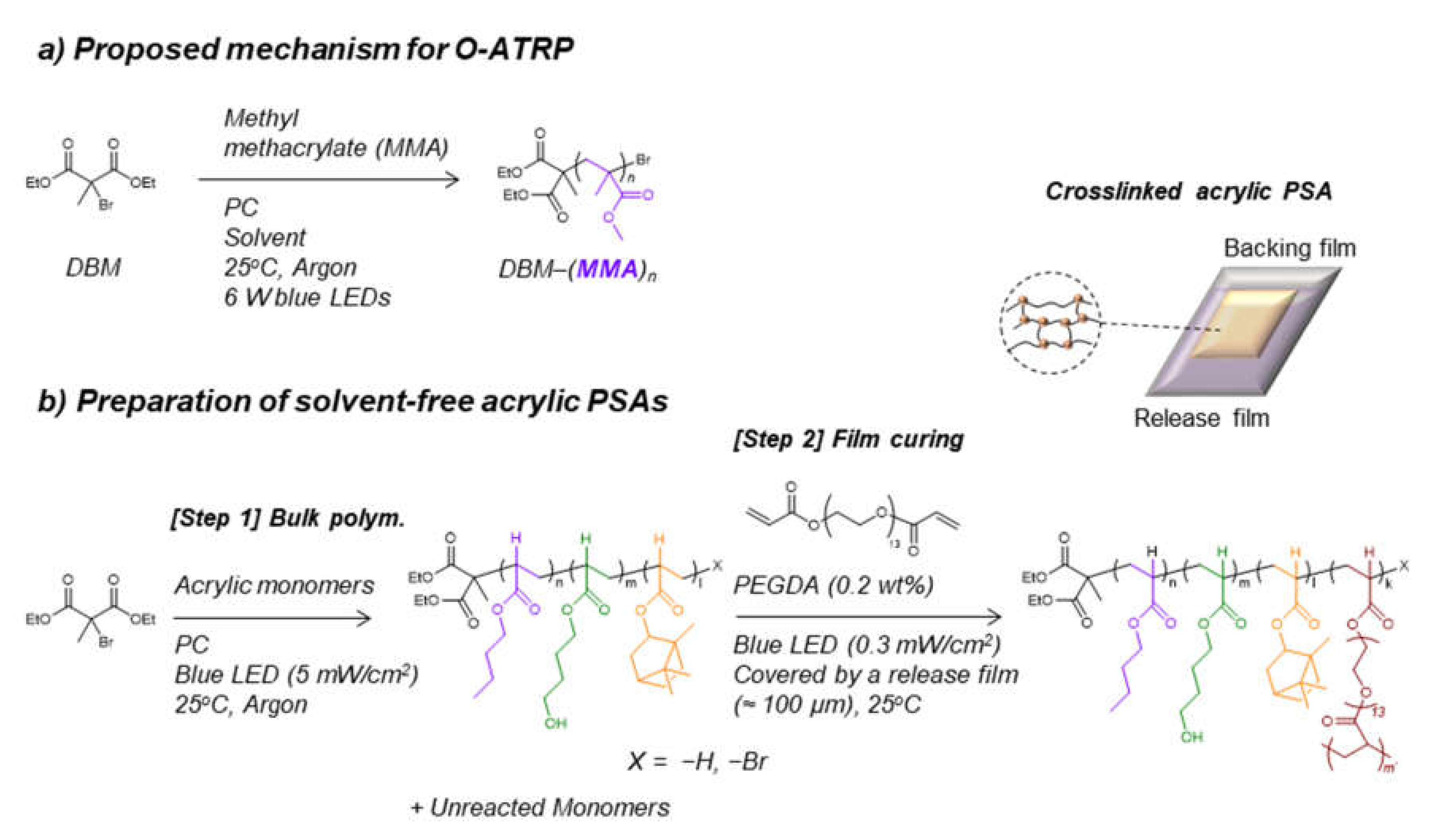
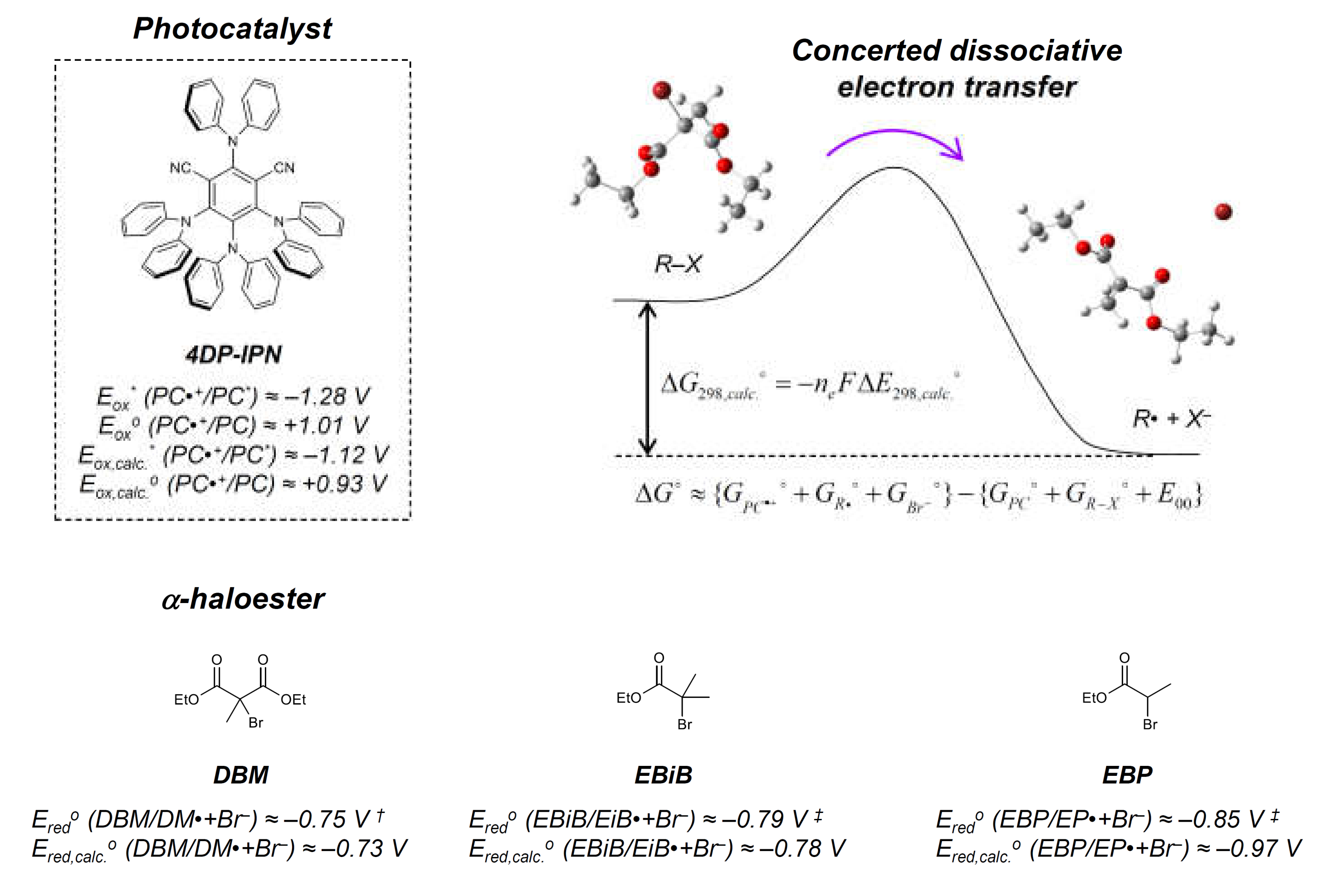
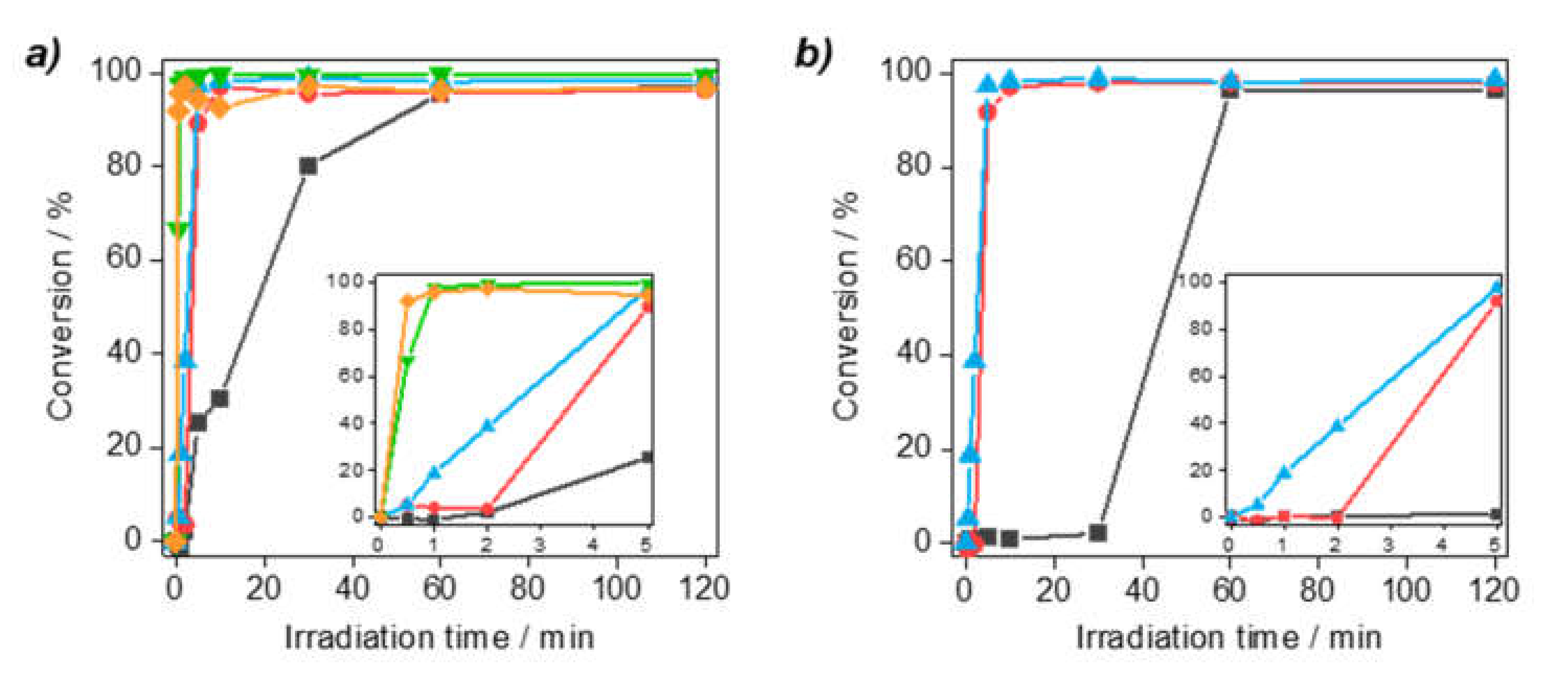
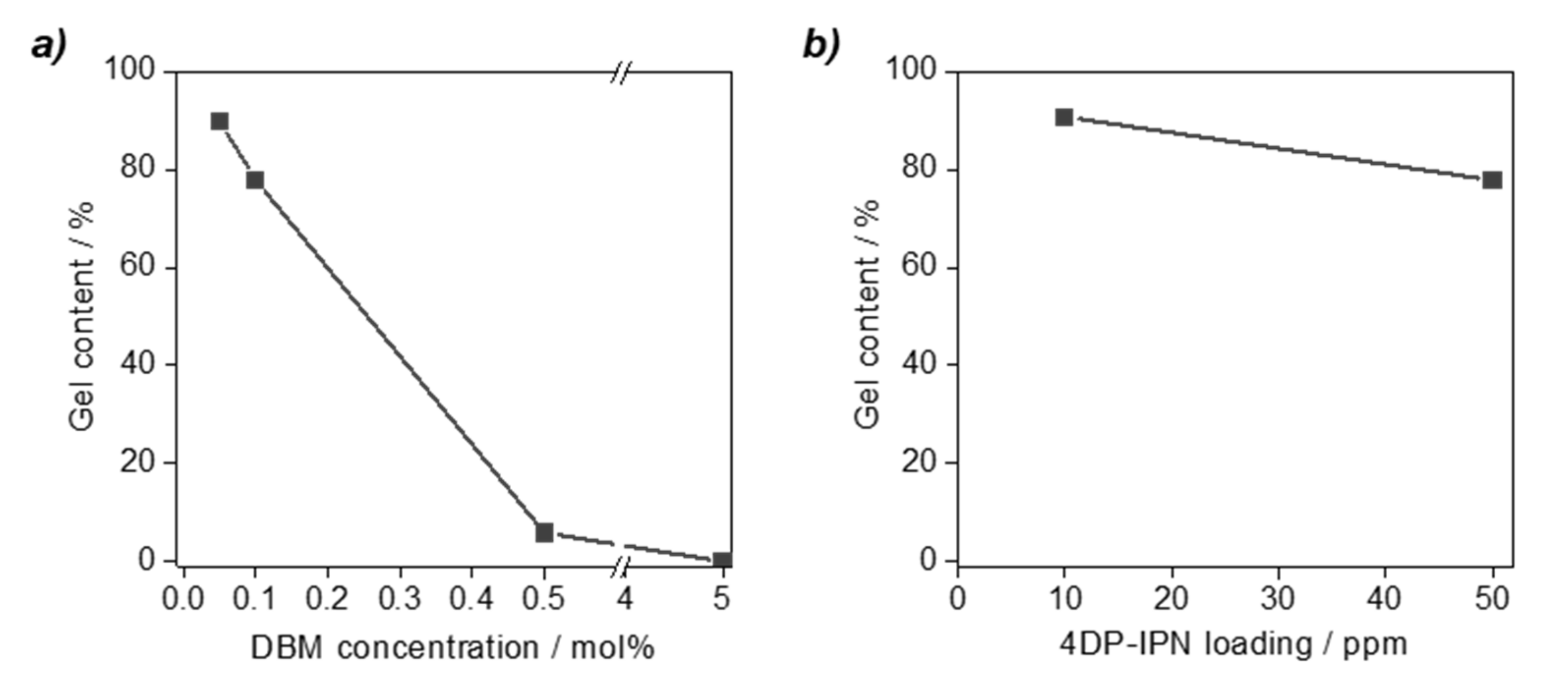
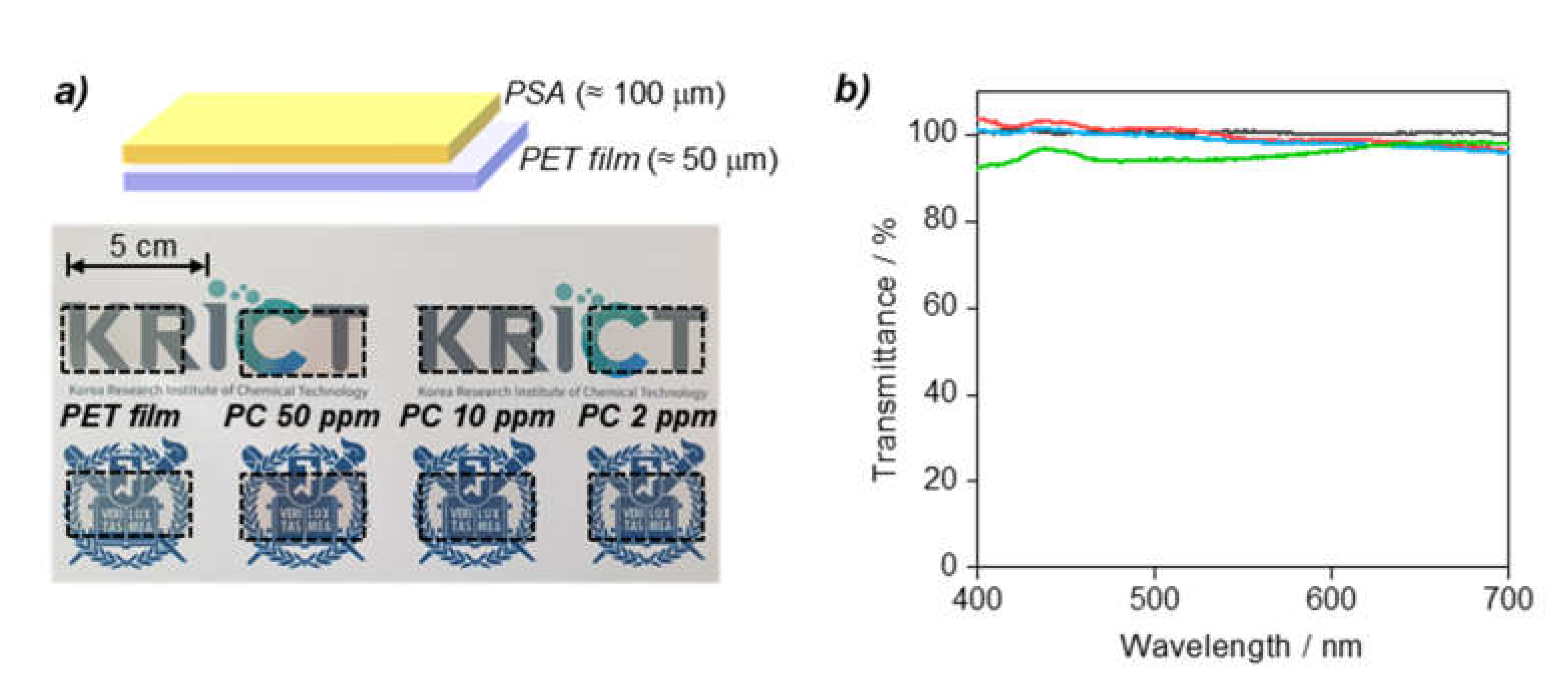

| Entry | α-Haloester | (M) a:(4DP-IPN): (α-Haloester) | Time (s) | α (%) | Mn (kg/mol) | Ð |
|---|---|---|---|---|---|---|
| 1 | - | 100:0:0 | >8 h | No separable polymers | ||
| 2 | DBM | 100:0:0.1 | >8 h | No separable polymers | ||
| 3 b | - | 100:0.034:0 | 15 | 7.42 | 873 | 1.68 |
| 4 | - | 100:0.005:0 | 600 | 11.2 | 418 | 2.34 |
| 5 | DBM | 100:0.005:0.1 | 10 | 11.7 | 289 | 2.51 |
| 6 | DBM | 100:0.001:0.1 | 10 | 7.68 | 512 | 2.35 |
| 7 | EBP | 100:0.005:0.1 | 180 | 7.76 | 749 | 1.83 |
| 8 | EBiB | 100:0.005:0.1 | 100 | 7.45 | 514 | 2.20 |
Publisher’s Note: MDPI stays neutral with regard to jurisdictional claims in published maps and institutional affiliations. |
© 2021 by the authors. Licensee MDPI, Basel, Switzerland. This article is an open access article distributed under the terms and conditions of the Creative Commons Attribution (CC BY) license (http://creativecommons.org/licenses/by/4.0/).
Share and Cite
Back, J.-H.; Kwon, Y.; Kim, H.-J.; Yu, Y.; Lee, W.; Kwon, M.S. Visible-Light-Curable Solvent-Free Acrylic Pressure-Sensitive Adhesives via Photoredox-Mediated Radical Polymerization. Molecules 2021, 26, 385. https://doi.org/10.3390/molecules26020385
Back J-H, Kwon Y, Kim H-J, Yu Y, Lee W, Kwon MS. Visible-Light-Curable Solvent-Free Acrylic Pressure-Sensitive Adhesives via Photoredox-Mediated Radical Polymerization. Molecules. 2021; 26(2):385. https://doi.org/10.3390/molecules26020385
Chicago/Turabian StyleBack, Jong-Ho, Yonghwan Kwon, Hyun-Joong Kim, Youngchang Yu, Wonjoo Lee, and Min Sang Kwon. 2021. "Visible-Light-Curable Solvent-Free Acrylic Pressure-Sensitive Adhesives via Photoredox-Mediated Radical Polymerization" Molecules 26, no. 2: 385. https://doi.org/10.3390/molecules26020385
APA StyleBack, J.-H., Kwon, Y., Kim, H.-J., Yu, Y., Lee, W., & Kwon, M. S. (2021). Visible-Light-Curable Solvent-Free Acrylic Pressure-Sensitive Adhesives via Photoredox-Mediated Radical Polymerization. Molecules, 26(2), 385. https://doi.org/10.3390/molecules26020385






